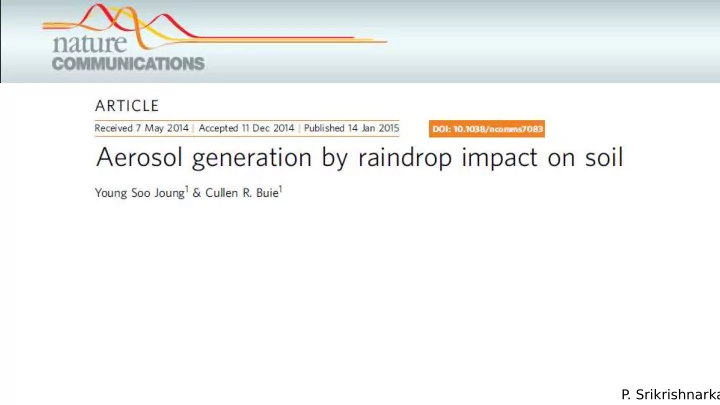

P . Srikrishnarka
Introducti on: Particles in lung Sky in Doha *All images from Google
Experimental section: Fig.1 (a) Schematic of experimental setup (b) Glass slide to collected the aerosol (c) slide under a UV fjlter to view Rhodamine spot (bright spots)
.1 . Droplet and aerosol generation in presence of air fmow Vid.2 . Droplet and aerosol generation in absence of air fmow
Fig.2 . (a) Clay loam with a rough surface before impingement with a droplet travelling at a speed of 2ms -1 . (b) Tiny bubbles form under the droplet after impact). (c) Tiny water jets are ejected from the droplet after impact. (d–g) High-speed images of the aerosol-generation process when a single bubble breaks inside the droplet. (d) A bubble is trapped inside the droplet. (e) The bubble breaks at the droplet/air interface. (f) A water jet emanates from the droplet. (g) The jet breaks up into tiny droplets.(h) Frenetic water jets and associated aerosols are generated on a thin layer chromatography plate after impact with a droplet travelling at 1.4 ms -1 .
Fig.3 Three-step process of aerosol generation after drop impingement on porous media. (a–c) High- speed images of bubble formationinside water droplets on a thin layer chromatography plate, composed of aluminium oxide particles (11–14 mm), with respect to impact velocity (Uo). (d–g) Schematic illustration of the aerosol-generation process.
Fig.5 Characterization of aerosol generation when Fig.4 Characteristics of droplets and bubbles droplets hit soils and porous surfaces. (a) The x generated after impingement on TLC plates. (a) axis indicates a modifjed Pe´clet number the y average droplet fjlm thickness is inversely axis indicates the Weber number mainly varied by proportional to Uo. (b) The maximum number of the impact velocity. bubbles inside the droplet linearly increases with respect to Uo governs the maximum bubble size at
Conclusions: This work present a visual proof of generation of aerosol by rainfall on soil Time scale for bubble formation(ms) is much lower than the hydraulic difgusivity(s) If the pores are fjlled with liquid, aerosols are not formed. However, once they are dried aerosols are generated again Efgect of successive rain drop and stability of aerosols have to be studied Future Work: Efgect of droplets on hydrophobic porous media Mode of generation of aerosol on angled surfaces
Thank you
Recommend
More recommend